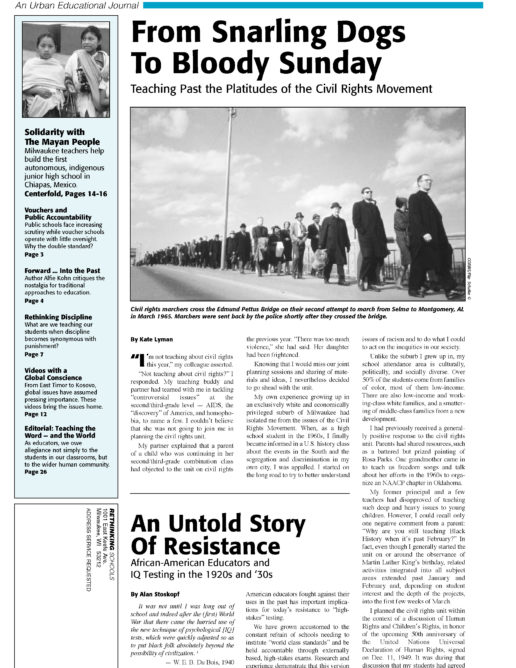Why the Secrecy?
Perhaps it’s my journalistic training, but when someone refuses to give me what should be publicly available information, I get suspicious.
So when Maureen Gallagher, director of Catholic Education for the Archdiocese of Milwaukee, refused to release information on the racial breakdown and test scores at Catholic schools in the voucher program, I wondered if she might be trying to hide something.
My ongoing correspondence with Gallagher started last spring, when a researcher for Rethinking Schools asked for information on the racial breakdown at Catholic voucher schools, including the racial breakdown of the voucher students. The issue is of more than passing interest, given the centrality of race to education politics in this city and the not-too-well-disguised fact that, in some cases, Catholic schools have been used by some white parents to avoid desegregation efforts in the public schools.
Gallagher gave us the run-around, such as complaints of not enough time. When I told Gallagher that we had the time and would compile the data from her records, she was blunt: “Are you kidding?” she told me. “We don’t open our files to anybody.”
Then in May, I heard through a well-placed source that the Archdiocese itself was worried because the test scores at some of the voucher schools were extremely low. In some cases, so the rumor went, the kids were doing worse than their MPS counterparts.
Is this true? I don’t know. But I wanted to find out. So I sent another letter to Gallagher, asking for the test scores at Archdiocesan voucher schools, particularly those 16 schools where more than half the students received vouchers.
This time Gallagher was equally blunt, although more formal. She wrote that the Archdiocese “cannot provide you with the additional information you requested.” The Catholic Schools, she wrote, are accountable to the parents, to the Church, and, as far the voucher funds go, to the Department of Public Instruction.
In other words, the general public has no right to know how well voucher kids are performing in the Catholic schools, even though the public is paying for their tuition.
Back in the days when private schools relied exclusively on private tuition and donations, such arguments were valid. But when public dollars are involved, and when the entire voucher program is premised on the assumption that private schools are providing a superior education to low-income children, the rules of the game have to be different.
I find Gallagher’s recalcitrance particularly curious given that in 1991, the one time the Archdiocese released even partially broken-down test scores, the findings showed that the Archdiocese’s gap between white students and African-American and Latino students mirrored that of MPS.
Now just in case you might think I’m picking on the Catholic schools, Rethinking Schools sent similar letters to all the voucher schools. As a group, the Catholic schools stood out by their refusal to release information. Further, the Catholic schools account for almost half of those receiving vouchers, and have a centralized bureaucracy that should be capable of providing basic data.
There are both educational and public policy concerns here. On an educational level, if the private schools are providing a better education, then it would be important to find out why – and how MPS could benefit from the findings.
But if low-income kids are not necessarily performing any better – and if, as any number of national studies show, socioeconomic status is the main determinant of how well a child will perform on standardized tests- then vouchers are not going to be the magic bullet that will cure Milwaukee’s educational woes.
Gallagher’s head-in-the-sand approach to public accountability is particularly galling given the “collaboration” between MPS and the Archdiocese, announced last spring. Shouldn’t collaboration begin with at least sharing basic information such as racial breakdown and academic performance?
Interestingly, those two Catholic schools that did return information on racial breakdown heightened fears that the voucher program may exacerbate segregation. One of the schools, Blessed Sacrament on the south side, had only one African-American among its 200 students. At St. Sebastian’s, located in a clearly multiracial neighborhood on the city’s west side, there were 26 African-Americans among its 446 students, or only 6%. In comparison, at nearby Hi-Mount, an MPS neighborhood school, 76% percent of the students were African-American in 1997-98.
Right now, the private schools can thumb their noses at anyone in the media or public who requests information. As a result, we have a voucher program that will eat up potentially $75 million a year in public funds, and absolutely no way to find out how well the schools are educating kids or how they may affect racial segregation.
We live in an environment of “get tough” school policies, with increasing requirements that public schools shape up and “be accountable.” Why are the voucher schools exempted from comparable scrutiny?
![]()
![]()

